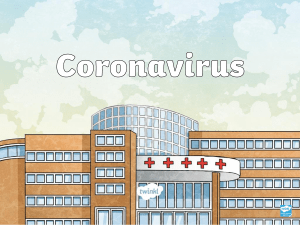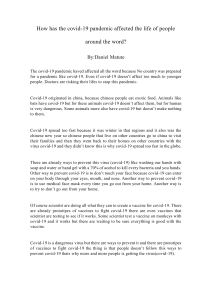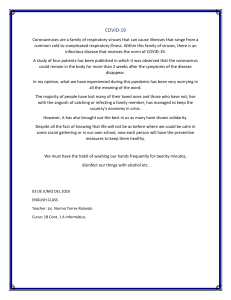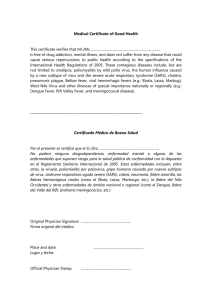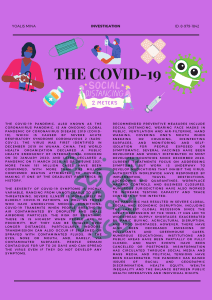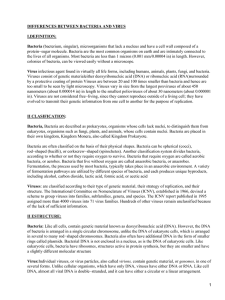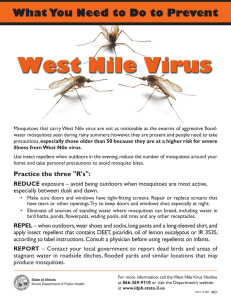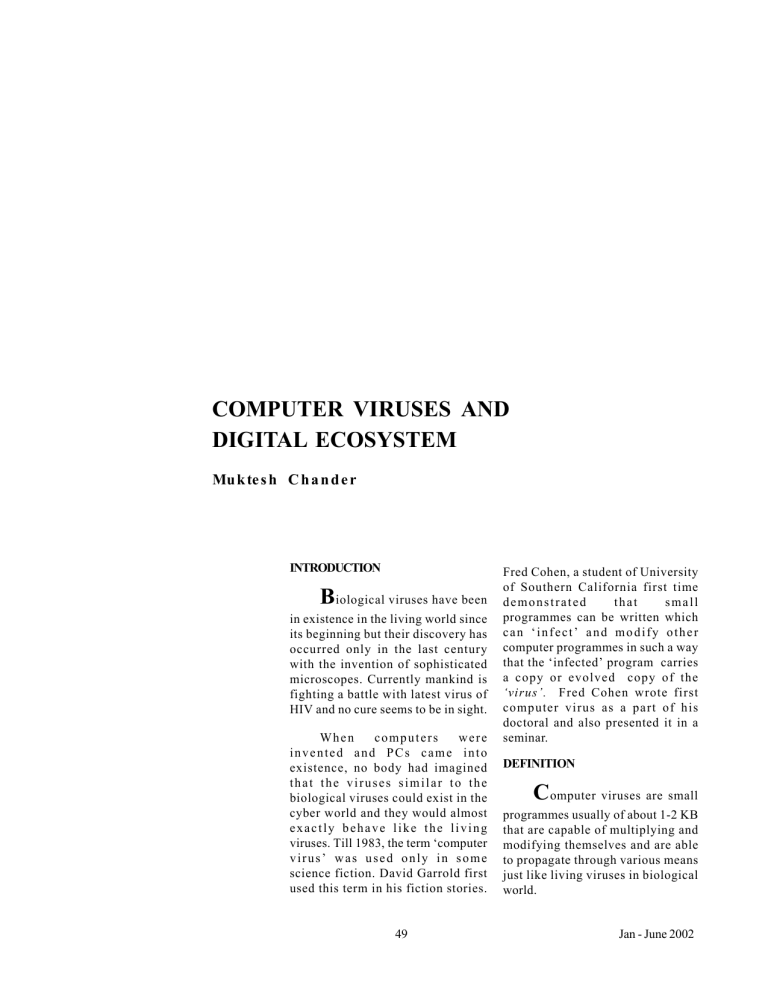
COMPUTER VIRUSES AND DIGITAL ECOSYSTEM Mu k te s h C h a n d e r INTRODUCTION B iological viruses have been in existence in the living world since its beginning but their discovery has occurred only in the last century with the invention of sophisticated microscopes. Currently mankind is fighting a battle with latest virus of HIV and no cure seems to be in sight. When computers were invented and PCs came into existence, no body had imagined that the viruses similar to the biological viruses could exist in the cyber world and they would almost exactly behave like the living viruses. Till 1983, the term ‘computer virus’ was used only in some science fiction. David Garrold first used this term in his fiction stories. 49 Fred Cohen, a student of University of Southern California first time demonstrated that small programmes can be written which can ‘infect’ and modify other computer programmes in such a way that the ‘infected’ program carries a copy or evolved copy of the ‘virus’. Fred Cohen wrote first computer virus as a part of his doctoral and also presented it in a seminar. DEFINITION C omputer viruses are small programmes usually of about 1-2 KB that are capable of multiplying and modifying themselves and are able to propagate through various means just like living viruses in biological world. Jan - June 2002 According to S-43 (h) (iii) of Information Technology Act, 2000, computer virus means any computer instruction, information, data or programme that destroys, damages, degrades or adversely affects the performance of a computer resource or attaches itself to another computer resource and operates when a programme, data or instruction is executed or some other event takes place in that computer resource. In order to understand the computer viruses, their comparison with biological counterpart is of great assistance. I would use this analogy to describe the computer viruses in detail in the following paragraphs. LIFE CYCLE Computer viruses are born when they are written by humans. They spread when a healthy computer comes in ‘contact’ with an ‘infected’ computer or programme or data. This could be through contaminated floppies or CDs just like transmission of sexual diseases or by exchange of mail, data, etc., through internet. After the ‘infection’ or contamination, a computer virus may remain in a dormant stage and during this incubation period it may continue to infect other machines, data or programmes without showing any symptoms of unhealthiness. In its active stage, a computer virus may affect the performance of a machine in several ways and the various symptoms shown are similar to that of a diseased person. The computer programmes may take longer time to perform a particular task. The disk activity and input/output activity may increase, system may hang or crash frequently. Files are either corrupted or completely disappear. Hard disk gets formatted automatically wiping out everything it contains. There could be bad sectors in the hard disk or frequent file reading errors. The file size of some Academy Journal files may increase due to lodging of virus in them. There could be unusual sounds or messages on the screen. In the worst scenario, the computer may not boot by itself. Under all these situations, performance of a computer may get affected in one of way or the other. Having noticed the presence of a virus in a computer, it is necessary to identify, with what kind of virus the computer is infected and try to cure the system and to recover the infected program or file, which may not be possible always. I would discuss the details of this in subsequent paragraphs of this article. 1) Boot Sector Virus & File Virus: Boot sector is that part of the computer hard disk memory where programme to load operating system resides. Every time a computer is started, the booting programme is executed and if a virus exists there, it will activate every time when computer starts. Such viruses are very effective as removing its copy from any other part of the computer will not remove it. On the other hand, file sector virus only affects programmes or files and normally deletion of infected file removes the virus also. About 5% of total viruses found are boot sector viruses and 85% are file infectors. Bimodal viruses are capable of infecting both boot records and files. The computer viruses are designed to multiply and spread. Some of the computer viruses have been found to multiply at exponential rate and have the capability of infecting thousands of computers within hours. There is a need to develop vaccines for viruses as soon as they are noticed. Once a cure for a virus is developed by antivirus specialist, it has to be incorporated into antivirus programmes and other software, so that unaffected systems can be immunized. 2) Over-writing and Appending Viruses: The virus code is approximately 1-2 KB in length. The virus writes itself normally in the beginning of the host programme without affecting the normal functioning of programme. If it appends itself to the host programme, it is called appending virus and when the host programme starts, virus code is executed first. The over-writing virus writes its code over the host code and thereby normally the host programme is unable to run properly. During propagation, a computer virus may mutate to different forms also, to avoid detection. 3) Based on where the virus stores itself, it can be called memory resident or non memory resident virus. Computer viruses form only a part of a large number of other mischievous programmes which can be collectively called malicious codes or programmes. There are malicious codes like Trojan Horses, bacteria and worms. Viruses differ from most of them as they posses the quality of replication but need a host programme to do so. 4) Stealth Virus: A virus which conceals itself is called stealth virus. Most of the viruses in existence today are stealth viruses. B ased on various criteria, 5) Polymorphic virus (Mutating virus): A virus which modifies its codes periodically or every time it infects other programme to avoid its detection is called a mutating or polymorphic virus. This gives rise to several strains of a particular virus. computer viruses can be classified in several ways. Some of them are discussed below. 6) Macro Virus: Documents made on recent word processors, spreadsheets CATEGORISATION OF VIRUSES 50 and datbases management software have the capability of executing automatic script-based sequence of events, every time the file is opened. These scripts or sequence of codes are called macros. A virus can be written using such scripts or macros. These viruses spread faster as most of these files of word processors or DBMS are shared frequently. ‘Concept’ was the first macro virus written in MS Word macro in 1995 and is the most prevalent virus. 8) Encrypted Virus: A virus, which uses encryption technology to prevent detection, is called encrypted virus. The code of an encrypted virus begins with decryption algorithm and is followed by encrypted code of the remaining virus. Each time it infects other programmes, it is automatically encoded by a different key and therefore its code is never the same and it is able to fool Antivirus Software. 9) Web site Virus: As soon as a web page is loaded in a computer, a code written in one of the languages like HTML is executed. A virus code can be written in JAVA Script embedded in HTML code which executes, when the web page is visited. Such scripts are capable of making several changes in the host machine, including deletion of files. Such viruses are called website viruses. HISTORY OF COMPUTER VIRUS ‘Brain’ was the first virus which spread in the wild in 1987 and was written in MS DOS by some Pakistani. It was a boot sector virus and infected only 360 K floppy disks. ‘Jerusalem’ was the first file infector virus. Since then, we have seen viruses like Raindrop, Yankee doodle, PC stoned, Michael Angelo, etc. Melissa virus which spread in March, 99 was written in Word macro. It caused damage to the tune of about $80 million to computers world wide. ‘I Love You’ virus was written in Visual Basic script and it caused loss of about $15 billion world wide. The virus originated from Philippines. Some other viruses recently active are Code Red (July 2001), Goner (Dec 2001). DAMAGE CAUSED BY VIRUS A large number of viruses are harmless but there are thousands of viruses which have caused damage to millions of computers, PCs and networks allover the world. As per a survey conducted by National Computer Security Association of USA in 2001, out of the companies whose computers were affected by viruses, 62% reported loss of productivity, 41% reported lockup or interference, 38% reported corruption of files and 30% reported loss of data. With the increase in the number of viruses in the wild, every computer is vulnerable to damage caused by viruses. DETECTION OF VIRUS Normally, the presence of a virus is revealed by tell tale symptoms. But many a time it is not possible to detect this without a detection software. There are two kinds of Antivirus Technologies: i) Generic/Heuristic Virus Detection: These antivirus programmes are not virus specific and work on the principle that presence of virus alters memory and modifies certain crucial files in specific manner. In a way they watch for effects of viruses rather than the virus itself. So in such generic way they are capable of detecting even unknown or future viruses. Their operation is simple and fast but can also give false positive error showing presence of a virus even though no virus is present. ii) Scanning Antivirus Detector: They work on the principle that for every virus it is possible to identify a string of 10-30 bytes in its code which is unique to the 51 virus. This unique string is called ‘Virus Signature or Definition’ and while scanning for viruses in various files and memory, this virus signature is searched. In this kind of detection, the possibility of false alarm is very less but the disadvantage is that they can detect only those viruses, whose virus signatures or definitions are in its database. For previously unknown viruses false negative error would occur. Such antivirus programmes need periodic updation to cope up with new viruses which are being generated every day by dozens. Extracting a virus signature is a difficult and laborious process but now automatic software techniques are also available. Even though while searching for a virus signature in a suspected system, very efficient pattern matching algorithms are used, still they are very slow as they have to scan the entire memory and this may take several minutes. Once a file containing a virus is detected, the Antivirus Software tries to delete the viral code from the infected file or from memory. If it is not possible to delete the code, the file is quarantined so that it is not able to infect other files and propagate further. Alternatively, the infected file can be replaced by a new copy of the programme. Some of the famous Antivirus Vaccines are Norton, Mecaffe, PC Cillin, Dr. Solomon, etc. Many vaccines are available free of cost to home users and there are many online sites which can scan your PC for presence of virus. DIGITAL IMMUNE SYSTEM Research is being carried out at present to make Digital Immune Systems by many computer companies including IBM. In biological world, a living creature has the inbuilt capability of fighting any outside or foreign body by creating antibodies. Once such immunity is developed any subsequent exposures to virus is controlled by these antibodies. Jan - June 2002 In a Digital Ecosystem, there could be created what would be called Digital Immune system. In such a system of inter connected computer, each computer would monitor the presence of computer virus by a generic virus detecting system. Once a suspected virus is detected, a copy of infected file would be sent by the computer to a Central Virus Analysis Laboratory, which is a sophisticated system capable of analyzing the viral code by luring it to infect decoy programmes under controlled conditions. After analysis, the viral signature and its cure is extracted automatically and the same is being sent to each computer in the network, including the infected computer. The infected computer is secured of the infection and in this way all the computers in the network become immune from the subsequent attack of the virus. WHAT LIES IN FUTURE? Whether we like it or not, viruses and other malicious codes are likely to stay and evolve with the computer technology. For various reasons, virus writers would keep on writing better and more deadly viruses. Efforts are also being made by various people to write ‘Flash Worm’ which would be able to propagate at lightening speed and cripple millions of computers world wide in a matter of several minutes. There is a saying in army that “Do not send a man where you can send a bullet”. The same can be modified in a cyber war context as “Do not send a bullet where you can send a byte”. Computer viruses can be deadly tools in the hands of international terrorists like Osama Bin Laden, whose organization Al-Queda is known to be using strong encryption, steganography and internet technologies to plan and organise terrorist acts. A day is not far off when such terrorist attacks would be executed in the cyber space using what can be called Digital Inter Continental Ballistic Missiles in the shape of logic bombs, computer viruses and worms. Millions of computers and networks may collapse just like World Trade Center’s twin towers wiping billions of computer files and data and crippling the entire world. Cyber terrorism is not a myth and can be a, not so distant, reality. PRECAUTION TO BE TAKEN The old saying “Prevention is better than cure” applies to the cyber space also. Simple precautions which must be taken are: i) Always scan your system, floppies & CD., incoming and outgoing e-mail with good latest Antivirus Programme. ii) Do not open any e-mail attachment unless you are sure of its origin. iii) Update virus definitions, virus signatures and programmes of your Antivirus Software. v) vi) Disable automatic execution of Macros, Java Scripts and Active-X controls. vii) Make some Antivirus Tool Kit to enable you to boot your system from floppy in case of trouble. viii) Backup your data regularly. ix) Do not use pirated software and freebies. x) Stay calm and note down what is happening to your PC, when it is struck by a virus. Shut down and call for experts help if you are not sure what to do. xi) Regularly update your software so that the vulnerable bugs and holes are patched. CONCLUSION Although virus writing and its release is a criminal act in many countries, unfortunately as per IT Act 2000 of India, it is only a civil offence. We have to learn to live with the viruses and guard ourselves against them. Every computer user must take precautions. It is yet one more fight between the good guy and the bad guy and has to be fought by all for the benefit of cyber community and every nation in this world must unite and cooperate in this endeavour. iv) Do not visit suspicious sites or bulletin boards. It’s difficult for humans to accept the phenomenon of coincidence; they always look for explanations Academy Journal 52 Do not download from unreliable sites. ***
